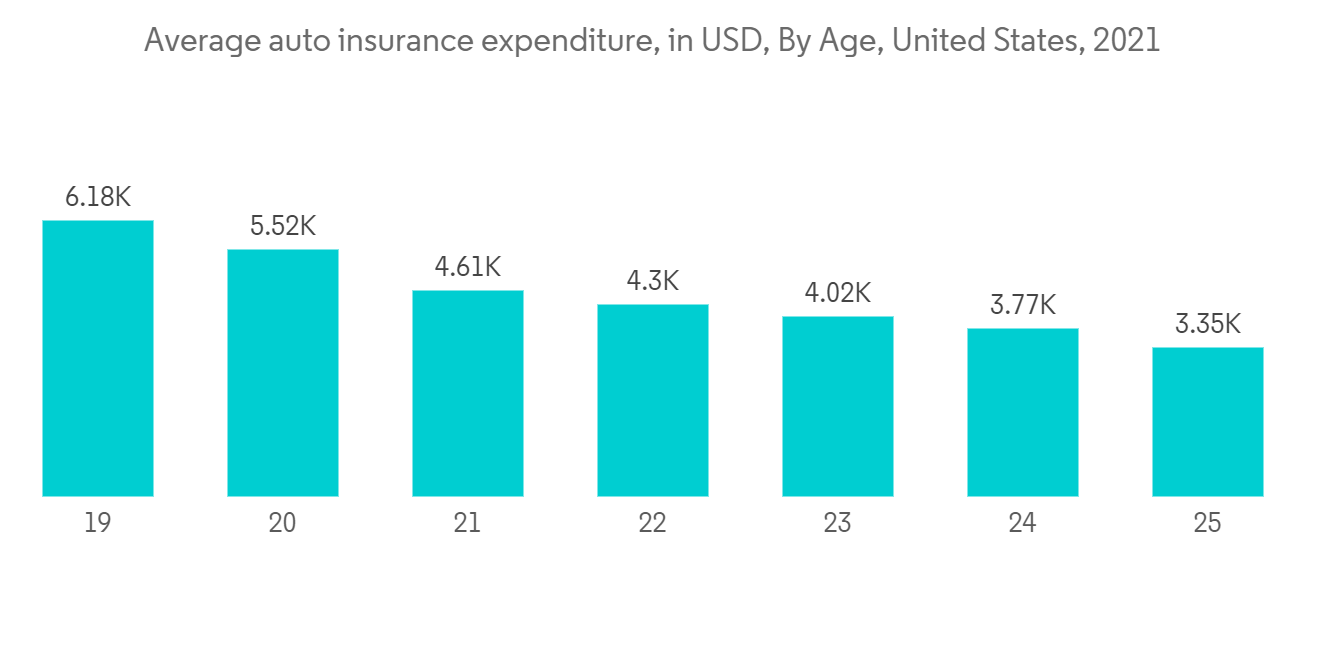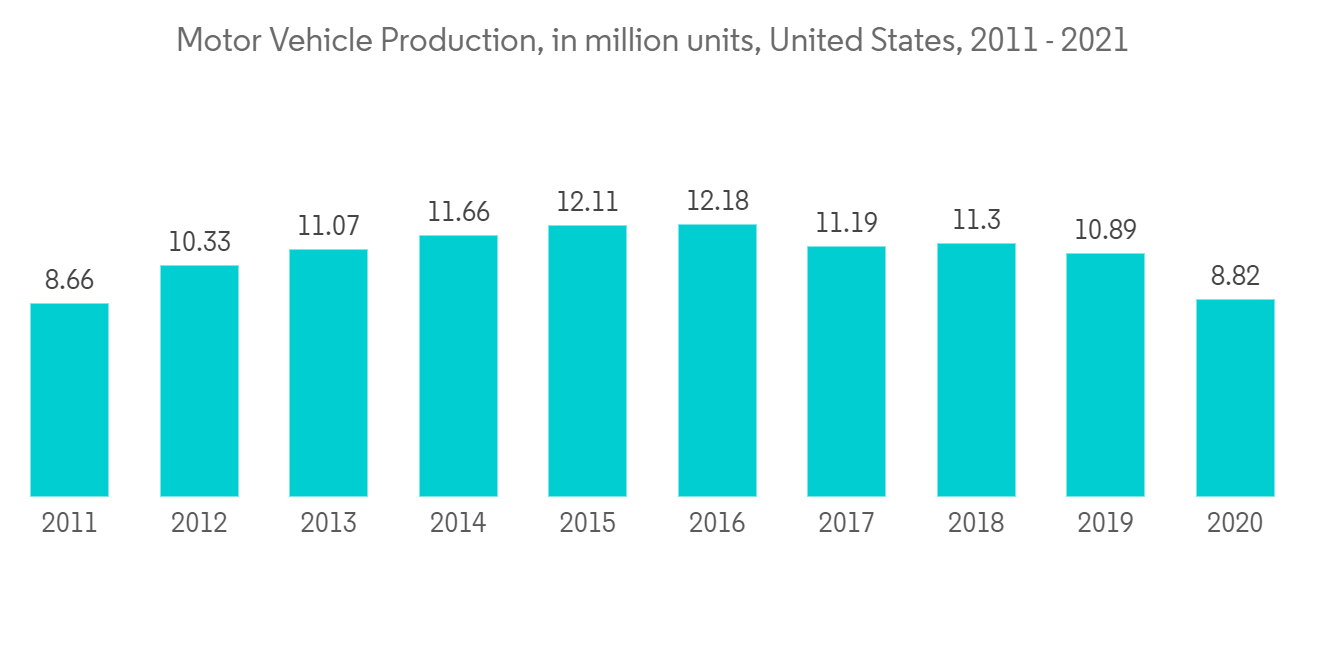North America Insurance Telematics Market - Growth, Trends, COVID-19 Impact, and Forecasts (2022 - 2027)
North America Insurance Telematics Market is expected to grow by 21.45% CAGR in the forecasted period from 2022-2027.
Key Highlights- Telematics is a term that combines the terms telecommunication and informatics. Telematics is used in vehicle insurance to track, store, and send driving-related data. This information is useful in determining driving habits and appropriate vehicle insurance premiums. Pay-as-you-drive, Pay-how-you-drive, and Manage-how-you-drive are three usage-based insurance-based telematics income models.
- North America Insurance Telematics Market is expected to grow by 21.45% CAGR in the forecasted period for telematics-enabled usage-based insurance (UBI) for discount purposes.
- According to a LexisNexis Risk Solutions poll of US consumers conducted in December 2021, 71% are interested in using telematics-enabled usage-based insurance (UBI) for discount purposes. Consumer acceptance, on the other hand, is still quite low, giving a major opportunity for both consumers and insurers.
- In the wake of the global pandemic COVID-19, which has thrown asset-heavy businesses like rental companies into disarray, fleet management vendors are developing new use cases for their customers to help them shift fleets to meet the growing demand for logistic and medical transportation, thereby fostering the market growth.
- The first UBI initiatives appeared in the United States over a decade ago when Progressive Insurance Company and General Motors Assurance Company (GMAC) coupled GPS technology and cellular systems to give mileage-linked discounts. Roadside assistance and vehicle theft recovery were (and still are) frequently bundled with these savings. Recent technological advancements have boosted the efficiency and cost of telematics, allowing insurers to track how many miles people drive and how and when they drive. As a result, numerous UBI variants, such as Pay-As-You-Drive (PAYD), Pay-How-You-Drive (PHYD), Pay-As-You-Go, and Distance-Based Insurance, have grown in popularity.
- Usage-based insurance (or UBI) uses a special tracking device (usually placed within a client’s vehicle) to track driving behavior. By examining how a driver accelerates, brakes, and corners, the idea is that an insurance company can determine a more appropriate premium for that client. Insurance companies who have adopted these programs also examine when a client drives and how much time they spend behind the wheel.
- In the coming years, the expansion of the vehicle industry is likely to move the usage-based insurance market forward. The automotive industry comprises many firms and organizations involved in automobile design, production, marketing, and sale. Telematics-driven usage-based insurance appeals to car owners since it offers low premiums for low-risk driving and high premiums for high-risk driving. As a result, individuals can significantly reduce their insurance prices by changing their driving behaviors.
- Light-duty vehicles (LDV) and heavy-duty vehicles (HDV) are the two most common vehicle classes for usage-based insurance (UBI). Passenger automobiles with a maximum gross vehicle weight of fewer than 8500 lbs are classified as light-duty vehicles, whereas heavy-duty vehicles have a higher gross vehicle weight. OBD-II-based UBI programs, smartphone-based UBI programs, hybrid-based UBI programs, and black-box-based UBI programs are among the several technologies that are utilized in various sorts of packages such as pay-as-you-drive (PAYD), pay-how-you-drive (PHYD), and manage-how-you-drive (MWYD).
- One point of contention is privacy. It’s one thing for private individuals to choose usage-based insurance, but it’s quite another for business fleets to demand that their drivers be regularly watched. However, with telematics, the usual norm is that measurable benefits eventually surpass any privacy concerns, which can be largely handled by anonymizing data collection and processing. In reality, tracking and reporting on driving behavior might be a positive experience for drivers, allowing them to improve their performance against various benchmarks, thereby gamifying the practice of safe driving.
- The nationwide ELD mandate, which took effect on June 12, 2021, is the most recent change facing carriers in Canada, according to Insurance Business Canada. While many fleets (especially those with US cross-border exposures) have already been using telematics service providers (TSPs) with ELD tracking capabilities, regulated vehicles in Canada will have to use many of the same TSPs to capture their hours of service, even if they are only operating in Canada.
- According to the American Automobile Association’s (AAA) 2021 Your Driving Costs report, the average cost of owning and operating a 2021 model car 2021 when driven 15,000 miles per year was USD 9,666. The average full-coverage insurance cost for a medium car was USD 1,403, while a medium SUV was USD 1,296. All cars, including pickups and hybrid and electric vehicles, had an average insurance premium of USD 1,342. AAA insurance quotes are based on a full coverage policy for a motorist under 65 years old who has more than six years of driving experience, has never been in an accident, and lives in a suburban/urban area.
 United States to account for largest Market Share
United States to account for largest Market Share- Progressive, Allstate, Liberty Mutual, Nationwide, and State Farm are the market leaders in North America, while Intact Financial Corporation and Desjardins are the market leaders in Canada. Most active policies in North America are self-installed OBD devices and smartphone applications.
- In the United States, Cambridge Mobile Telematics is becoming a market leader in the insurance telematics industry. TrueMotion and Arity are two other well-known providers of smartphone-based insurance telematics solutions (a subsidiary of Allstate). The COVID-19 pandemic has accelerated the use of smartphone-based insurance telematics coverage. Insurers who have released smartphone-based telematics solutions will have an edge since they can implement UBI policies without installing telemetry devices, avoiding unnecessary human contact.
- According to the Lexis Nexis 2022 US Auto Insurance Trends study, US auto insurance shopping growth declined to -5.2% in the fourth quarter of 2021, down from -3.9% in the third quarter. The decrease was caused by a vehicle shortage and rising claim costs. Vehicle shortages and supply chain concern hampered the introduction of modern driver aid technologies, resulting in lower automobile sales (ADAS).
- According to Insurify, the average national cost of car insurance is predicted to rise 5% to USD 1,707 per year in 2022, up from USD 1,663 in 2021. The forecast for 2022 is consistent with predicted inflation rates and considers the sustained rise in risky driving behaviors, which have been more common after the 2020 Covid lockdowns. Meanwhile, according to Insurify's study, Americans drove 32% more miles in March, April, and May 2021 than in the same months in 2020, when early pandemic shutdowns resulted in fewer cars on the road.
- New light-vehicle sales in the United States grew to 14.3 million units on a seasonally adjusted basis in April 2022, up from 13.3 million units the previous month, according to National Automobile Dealer. However, sales in April 2022 were down 21.9% from the phenomenal sales pace observed in April 2021, which was driven by strong consumer demand and sufficient inventories to match that need. April 2021 was one of the last months of sales before inventory began to dwindle and sales slowed dramatically.
 Competitive Landscape
Competitive LandscapeThere are several prominent participants in the insurance telematics business. Regarding market share, nearly none of the market players now hold a considerable position. The major competitors are concentrating on growing their consumer base beyond international borders to stay on top of the industry. These businesses use strategic collaboration initiatives to grow their market share and profits. Industry players are also purchasing start-ups working on insurance telematics market technology to strengthen their product capabilities.
- In January 2022 - With the debut of IntelliDrivePlus, The Travelers Companies, Inc. expanded its telematics vehicle insurance products. The app-based technology determines a new premium at each renewal by tracking miles driven and driving habits, including braking, acceleration, speed, time of day, and distraction. Customers in Arkansas, Nebraska, and Ohio can now use IntelliDrivePlus.
- In November 2021 - Owners of Mitsubishi vehicles can opt-in to share telematics data through the Mitsubishi Road Assist+ app in exchange for possible insurance premium discounts. LexisNexis Risk Solutions revealed this feature on November 11, 2021. The data will be added to LexisNexis Telematics OnDemand, allowing auto insurers to integrate telematics-based driving behavior data into their rating and underwriting workflows.
- The market estimate (ME) sheet in Excel format
- 3 months of analyst support
- 1 INTRODUCTION
- 1.1 Study Assumptions and Market Definition
- 1.2 Scope of the Study
- 2 RESEARCH METHODOLOGY
- 3 EXECUTIVE SUMMARY
- 4 MARKET INSIGHT
- 4.1 Market Overview
- 4.2 Industry Attractiveness - Porter's Five Forces Analysis
- 4.2.1 Threat of New Entrants
- 4.2.2 Bargaining Power of Buyers/Consumers
- 4.2.3 Bargaining Power of Suppliers
- 4.2.4 Threat of Substitute Products
- 4.2.5 Intensity of Competitive Rivalry
- 4.3 Industry Value Chain Analysis
- 4.4 Impact of COVID-19 on the Industry
- 5 MARKET DYNAMICS
- 5.1 Market Drivers
- 5.1.1 Increasing Adoption of Usage-based Insurance by Insurance Companies
- 5.2 Market Challenge
- 5.2.1 Data Quality and Compatibility Issues
- 6 USAGE BASED INSURANCE TELEMATICS - REVENUE MODELS
- 6.1 Pay-as-you-drive
- 6.2 Pay-how-you-drive
- 6.3 Manage-how-you-drive
- 7 COMPARATIVE ANALYSIS OF VARIOUS TYPES OF TELEMATICS HARDWARE BASED INSURANCE SOLUTIONS
- 7.1 Portable
- 7.2 Embedded
- 7.3 Smartphone Based
- 8 MARKET SEGMENTATION BY COUNTRY
- 8.1 United States
- 8.2 Canada
- 9 COMPETITIVE INTELLIGENCE
- 9.1 Towergate Insurance
- 9.2 Unipolsai Assicurazioni SpA
- 9.3 Octo Telematics SpA
- 9.4 Drive Quant
- 9.5 IMERTIK Global Inc.
- 9.6 AXA S.A.
- 9.7 The Floow Limited
- 9.8 LexisNexis Risks Solutions
- 9.9 Vodafone Automotive SpA
- 9.10 Viasat Group
- 9.11 Cambridge Mobile Telematics
- 9.12 AllState Insurance Co.
- 9.13 State Farm Mutual Automobile Insurance Company
- 9.14 Allianz p.l.c.
- 10 INVESTMENT ANALYSIS
- 11 FUTURE OF THE MARKET

Learn how to effectively navigate the market research process to help guide your organization on the journey to success.
Download eBook